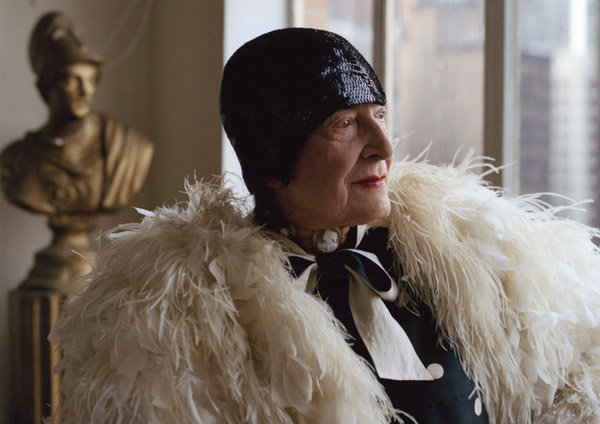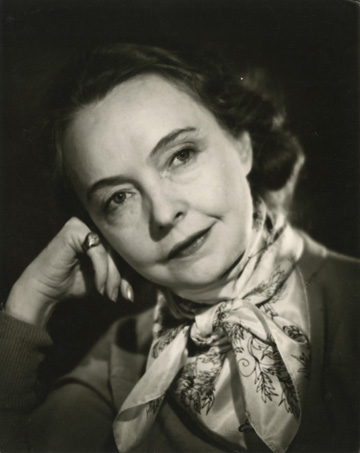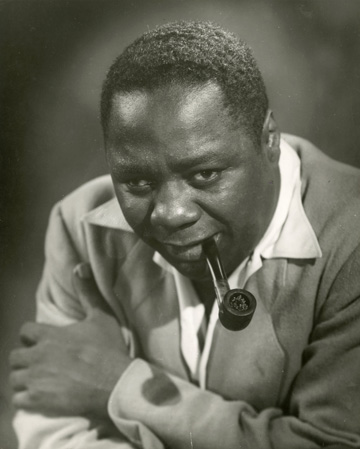
BY DAVID NOH | At the New-York Historical Society right now, you can meet the best unknown portrait photographer of the last century, Editta Sherman. Although she died four years ago, her presence is very much alive here in the huge, vintage 8×10 camera with which she plied her trade (the same one the great George Hurrell used to glorify Golden Age Hollywood stars), the flamboyant hats and garments which made her such a vivid presence around town (captured on film by her great champion and neighbor, Bill Cunningham), and, especially, the glowing, ravishing records of the famous faces who traipsed through her Carnegie Hall studio to pose for her.

There they are, the truly greats, the likes of which shall never be seen again, surely not in this paltry age of Kardashians and Kevin Harts: Lillian Gish, looking beyond lustrous, the Queen of the World; my favorite actor, Charles Boyer, suavely omniscient; the great, forgotten black actor, Canada Lee; Gladys Cooper, doyenne to die for; Gertrude Lawrence, proving that conventional beauty has really little to do with absolute, innate glamour; the monumental profile of Basil Rathbone; Bela Lugosi, unashamedly striking a threatening Dracula pose; Tyrone Power, a Sherman favorite, the handsomest of matinee idols; Angela Lansbury at the pinnacle of her “Mame” fame; fellow shutterbug Andy Warhol; Carl Sandburg; Leopold Stokowski; what looks to be one of Sherman’s last works, Tilda Swinton, looking an androgynous double for David Bowie in platinum pompadour and bespoke suit; and the best portrait ever, in color, of Antonio Lopez, greatest of all fashion illustrators, who elevated his métier to art.
Dubbed by Cunningham the “Duchess of Carnegie Hall,” Sherman was born Edith Rinaolo in 1912, in Philadelphia, and grew up assisting her Italian immigrant father, himself a wedding and portrait photographer. In 1935, she married Harold Sherman, a sound engineer, with whom she had five children. Her husband’s ill health from diabetes necessitated her making a living with her camera, and she began taking pictures of celebrities on Martha’s Vineyard in the 1940s, using her formidable charm to coax them in front of her lens. The family moved to New York in 1948 and lived in Studio 1208, atop Carnegie Hall, which was only 900 square feet with a bathroom down the hall.

When it was discovered that the studio was not zoned to accommodate families, the children were shipped off to a Staten Island group home. Harold died in 1954, and Editta hustled even harder to make her own way as a rare woman commercial photographer. Her friendship with Cunningham resulted in his book “Facades,” which was a series of portraits by him of her dressed in their shared collection of antique clothing against the backdrop of various New York historical landmarks (reprinted and on sale at the museum).
In 2007, all studio tenants were informed by the City of New York, Carnegie Hall’s owner, that they had to move. Editta was one of the few tenants who resisted eviction and continued to live there, under siege, until 2011, when she moved to a Central Park West apartment. It was there that she died in 2013, age 101.
During the eviction proceedings, the wonderful filmmaker Josef Astor made a film about her and other Carnegie Hall holdouts, “Lost Bohemia” in 2011. For this exhibit, he culled various outtakes from that film and made a short movie, starring Editta. which delightfully records her flamboyant personality, entertaining friends with chatter and pasta and reminiscing about her colorful past.
THE DUCHESS OF CARNEGIE HALL: PHOTOGRAPHS BY EDITTA SHERMAN | New-York Historical Society | 170 Central Park W. at W. 77th St. | Through Oct. 15: Tue.-Thu., Sat., 10 a.m.-6 p.m., Fri., 10 a.m.-8 p.m.; Sun. 11 a.m.-5 p.m. | $21; $16 for seniors; $13 for students at nyhistory.org































